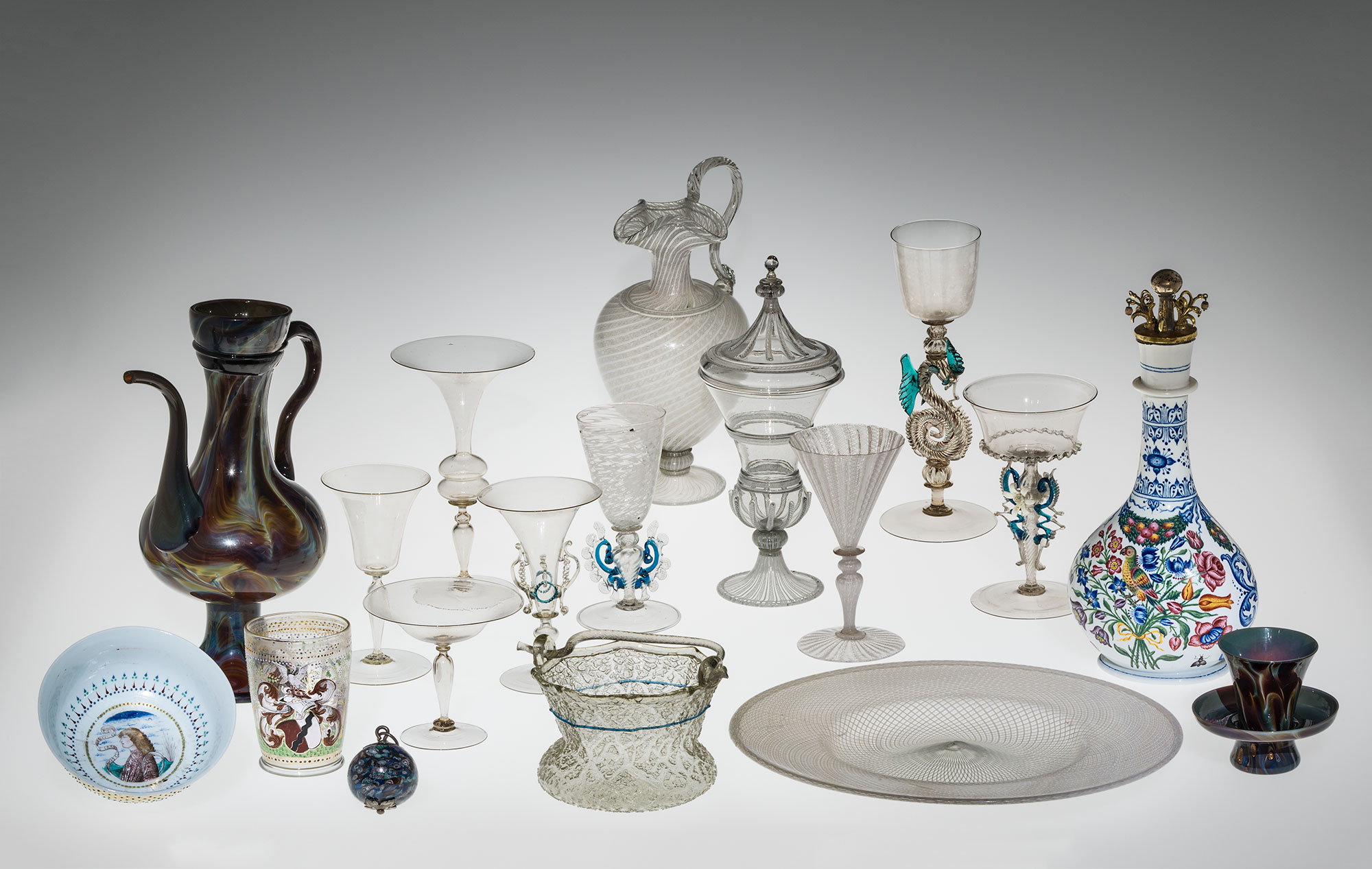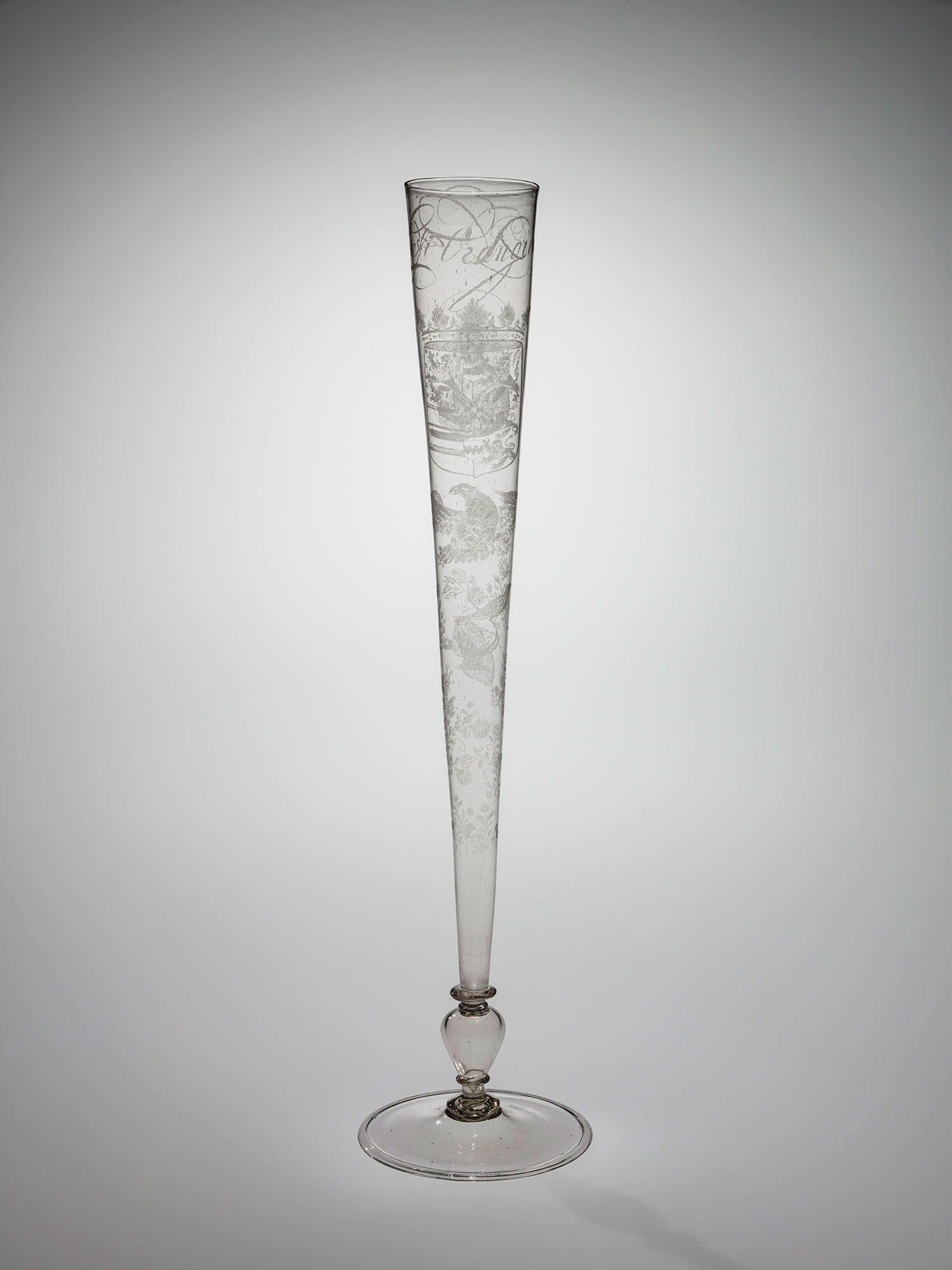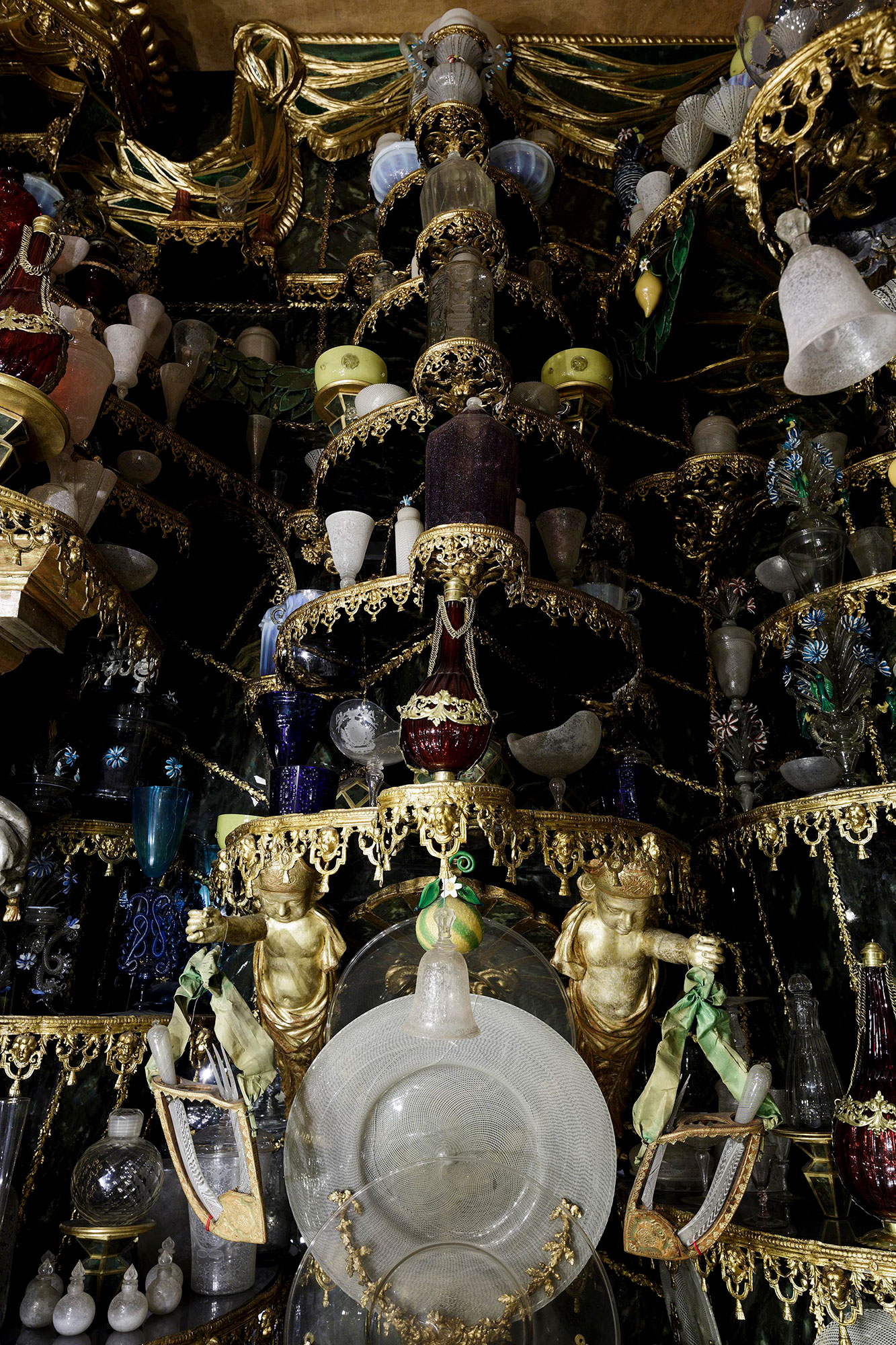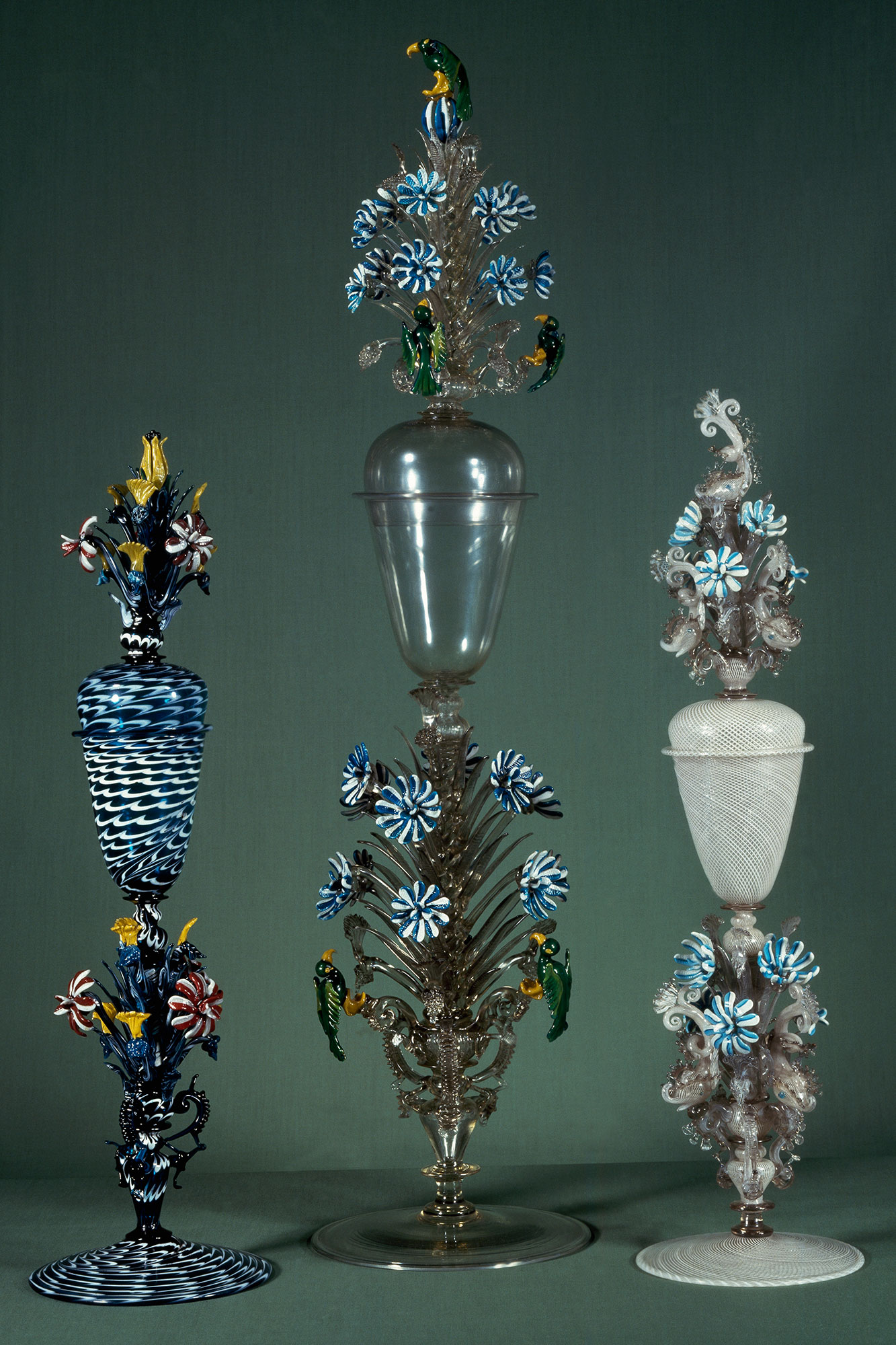Between about 1500 and 1700, the phenomenon of Venetian-style glass existed entirely because of the overwhelming popularity of Venetian glass itself (Fig. 11). Throughout western Europe, the wealthy and powerful, royals and aristocrats, sought the finest decorative arts objects and luxurious tableware for dining. Only glassware from Venice was deemed suitably prestigious for drinking (Fig. 12).4 Venetian glass vessels were limited in supply, difficult to ship, and expensive. Therefore, the demand for these “fragile Venetian beauties”—as the collector Felix Slade termed them5—was so great that skilled artisans fled Murano, Venice’s “glass island,” to seek their fortune working in places as far away as England and Sweden. The products that they created and sold abroad are the subjects of this e-book.
Introduction

Selection of objects representing Venetian glass manufacture between about 1500 and 1750. They are positioned approximately in chronological order, from left to right. Tallest (second from left) 30 cm. The Corning Museum of Glass (76.3.17, purchased with funds from the Museum Endowment Fund; 2001.3.56, gift of Robert and Deborah Truitt; 84.3.24, purchased with funds from the Museum Endowment Fund; 2004.3.44; 2009.3.85; 60.3.17; 2000.3.11; 79.3.212, bequest of Jerome Strauss; 79.3.476, gift of The Ruth Bryan Strauss Memorial Foundation; 2000.3.5; 64.3.20; 79.3.363, gift of The Ruth Bryan Strauss Memorial Foundation; 2014.3.24, purchased in part with funds from Kenneth R. Treis; 60.3.57; 51.3.118; 2000.3.14; 53.3.47a, b; and 51.3.315). Photo: The Corning Museum of Glass.

Paolo Veronese (1528–1588), The Wedding at Cana (detail). Venice, 1563. H. 6.7 m, W. 9.9 m. Musée du Louvre, Paris (inv. no. 142). Photo: © RMN-Grand Palais / Art Resource, NY.
At the outset, it must be said that the sharp distinctions, portrayed in much historical glass literature, between objects made in Venice and those made elsewhere in the Venetian style are often exceedingly difficult to define and defend convincingly. There are two fundamental reasons for this. First, we know that Venetian glassblowers traveled widely and made their wares in many different places at different times. There is thus no reason to assume that an individual worker’s objects should look any different whether they were made on Murano or in London, for example. Second, we know that, in the case of work intended for export, Venetian glasshouses redesigned and tailored their work to suit very specific local tastes. For these two reasons alone, we can seldom be certain of the place of manufacture of a given object. Two examples illustrate these points:
- Giacomo Verzelini (1522–1606) was a Venetian glassblower (see England) who obtained a patent in 1574 for making Venetian-style glass in London. Several goblets are more or less securely attributed to his glasshouse because of their diamond-point engraved decoration. Fortunately, they have dates worked into the decoration, all of which fall within Verzelini’s years of activity in London. However, apart from their decoration, in terms of their form and manufacturing technique, all of these objects could reasonably be described as “Venetian.” As stated above, there would presumably be no reason to suspect a difference between products made by Verzelini on Murano and in London.6
- Regarding the Venetians’ practice of making and exporting custom ware for various markets, an English traveler who visited Murano during the mid-17th century wrote: “An other day we went to Murano again to see the glass houses which furnish almost all Europe with drinking glasses ... They seem to have taken measure of every nation[’]s belly and humour, to fit them with drinking glasses accordingly: For the High Dutch, they have high glasses, called Flutes, a full yard long [Fig. 13] ... For the Italians that love to drink leisurely, they have glasses that are almost as large and flat as silver plates, and almost as uneasie to drink out of [Fig. 14].”7

Ale glass, blown, applied, engraved. Low Countries, about 1670. H. 45.3 cm; Diam. (rim) 5.7 cm, (foot) 11.1 cm. The Corning Museum of Glass (79.3.252, bequest of Jerome Strauss). Photo: The Corning Museum of Glass.

Tazza, vetro a retortoli. Venice, about 1550–1610. H. 13.8 cm; Diam. (rim) 15.5 cm, (foot) 7.8 cm. The Corning Museum of Glass (51.3.119). Photo: The Corning Museum of Glass.
Therefore, the attributions of these types of objects—which appear in books, exhibition and sales catalogs, and museum labels—are understandably and justifiably littered with question marks: Venice or France? France or Venice? Murano or France? Glass historians often employ the French term façon de Venise (style/fashion of Venice) or à la façon de Venise (in the style/fashion of Venice), which originated in the 16th century.8 One of today’s noted glass historians even goes so far as to suggest abandoning the effort to make a distinction between Venetian and Venetian-style glass. He argues that the exercise is essentially and ultimately arbitrary.9
Perhaps this is going too far because, amid the uncertainties, there are indeed groups of Venetian-style objects whose provenances are certainly known. For example, the small filigrana-decorated Swiss Goblet and the Winged Glass were surely made in Switzerland and the Low Countries respectively. This is because fragments of similar glasses, together with glassworking debris, have been found in each location.10 Archaeological evidence of this sort, from within reasonably closely datable contexts, provides rare sure footing for attributions.
On the other hand, when attempting to describe the origin of an object, how often can we be certain that it was, in fact, made in Venice? Unfortunately, seldom, and almost never based on evidence as strong as the Venetian-style examples noted above. There are, of course, long-established conventions that certain types of glasses are attributed to Venice. For instance, the 35 objects that I chose for my 2016 e-book The Techniques of Renaissance Venetian Glassworking are widely believed to be examples of Venetian glass. However, in at least a few cases, effective arguments could be made for non-Venetian origins.
... when attempting to describe the origin of an object, how often can we be certain that it was, in fact, made in Venice?
One of the most useful tools for attributing specific types of glasses to Murano/Venice is studying paintings by Renaissance masters who worked there. For example, it is reasonable to assume that the vessels included in the paintings of Titian, Tintoretto, and Paolo Veronese were made locally.
Long-held, intact collections offer another important method of assessing Venetian glass production at a particular time. The Glass Room in Copenhagen’s Rosenborg Castle houses a classic example (Fig. 15). In 1708–1709, King Frederick IV of Denmark visited Venice and was presented a state gift of “200 pieces of the finest Venetian glass.” In addition, he visited Murano and, on his own, purchased more glass. To the good fortune of later glass historians, he had the glasses shipped to Copenhagen and installed in a small but elaborately decorated space just off the throne room. There they remain, a reference collection without parallel (and open to the public) for later Baroque Venetian glass of the most elaborate sort (Fig. 16).11

The Glass Room at Rosenborg Castle, Copenhagen, Denmark. Photo: Peter Nørby. The Royal Danish Collection, Rosenborg Castle.

Glass goblets decorated with polychrome enamel. Venice, Muranese glass factory, about 1708. Rosenborg Castle, Copenhagen, Danske Kongers Kronologiske Samling. Photo: De Agostini Picture Library/Bridgeman Images.
There remains one additional ever-nagging concern about attributing glass objects to Venice. We know from contemporaneous sources that several glasshouses relatively near the upper Adriatic Sea were making glass “indistinguishable” from that made on Murano. At the top of the list must be the enigmatic products of Altare.
The town of Altare, situated not far from Genoa, where glassmaking was taking place in the 12th century, became one of Murano’s great rivals during the 16th century. Frustratingly, no specific object can today be linked with Altare, but its glassblowers were reportedly as skilled as their Muranese counterparts and produced work of equal quality. It is therefore impossible to say how much glass now identified as Venetian was actually manufactured in Altare. To add to the confusion, the same thing could be said of the glass objects produced in Genoa, Pisa, and Florence, to name just three other examples. They, too, made glass that was apparently indistinguishable from that created in Venice. So, like the muddy islands on which the city of Venice was built, attributions of glass objects to Muranese workshops almost always rest on slippery foundations.12
The attitude of glasshouse managers in Altare was markedly different from the policies of the Venetian government toward its Muranese maestros. While workers on Murano were famously forbidden by law to leave the island to work elsewhere, glassmakers from Altare were encouraged to travel.13
Much has been written about attempts by La Serenissima, the Republic of Venice, to control the glass industry and avoid the dissemination of the coveted trade secrets of Murano. Less often reported is the government’s willingness to officially sanction—at a cost—the exporting or lending of workers for limited engagements at the glasshouses of prestigious and wealthy foreign courts. Ironically, one of the first glassmakers affected by this practice was also one of the best-known Venetian glassmakers of the Renaissance: Angelo Barovier (d. 1460).
In 1455, Barovier and his son went to Milan to work for Duke Francesco Sforza. By that time, Barovier was well established as the inventor of cristallo, a glass with a theretofore unknown degree of clarity and colorlessness. Truly extraordinary circumstances must have been responsible for permitting the most famous glassmaker on Murano to set up a glass furnace in the Milanese court. At the time of his death, Barovier was reportedly Murano’s best maker of cristallo vases.14
Although this is completely outside the scope of the present publication, it is interesting to note that the practice of making Venetian-style glass continues today. Over the last 30 years or so, the glassmaking traditions of Venice, more than those of any other place, have been enthusiastically embraced by artists and craftspeople as part of the worldwide Studio Glass movement. In addition to being able to produce objects that look, more or less, like true Venetian-made ones, artists have discovered that possessing a facility working in the “Venetian style” allows great technical freedom. Employing a virtuoso Venetian technique makes everything else a little easier, and creativity at the glassblowing furnace is less hindered by technical problems (Figs. 17 and 18). Thus, over 300 years after the pan-European dominance of style and technique in luxury glassmaking by Venice, its ways of handling molten glass remain vital and relevant today.

Group of goblets made by James Mongrain (American, b. 1968), 2009. H. (tallest) 36.3 cm. The Corning Museum of Glass (2009.4.46, .47, .45, .43, .51). Gift of the artist. Photo: The Corning Museum of Glass.

Cadmium Yellow-Orange Venetian #398, blown with hot applications, manipulated while hot. U.S., Seattle, Washington, Dale Chihuly (American, b. 1941), 1990. H. 49 cm, W. 36.2 cm, D. 41.7 cm. The Corning Museum of Glass (90.4.129). Gift with funds from Mr. and Mrs. James R. Houghton. Photo: The Corning Museum of Glass.